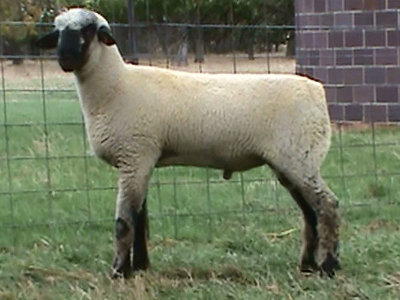Hampshire Sheep
Category: Sheep

Facts about Hampshire Sheep, "Scientific name for Hampshire Sheep is Ovis aries". Hampshire Sheep its original home is the Hampshire, which is located in the southern area of England. This area of England is rich with rolling hills, flatland's and lush green pasture that is much suitable for gazing. Various breeds are farmed in and around Hampshire and mixing of various breeds have eventually developed into this breed named Hampshire sheep. Hampshire Sheep breed is a combination of Southdown, Wiltshire, Berkshire knot as well as Old Hampshire. The Hampshire Sheep breed is a large breed that has got an open face.
There should be unbroken wool on the face of the Hampshire Sheep from neck and also over the forehead but make sure that the wool is not extended to impede it’s vision. The face of the Hampshire Sheep breed is covered with hair that is black or brown. The legs beneath hock and knee are of dark color and also free from wool. The Hampshire Sheep have thick and moderately long ears. A matured ram can weigh about 275 pounds (125 kg)and ewes about 200 pounds (90.7 kg). Ewes can have fleece of about 6 to 10 pounds (2.7 kg) as well as length of 2 to 3 inches (5 to 7.6 cm). There are less chances for the Hampshire Sheep breed to go through any ailments and they are generally healthy and easy for handling. The lambs of the Hampshire Sheep breed have dark shade but the hair lightens as it gets matures and becomes white in color. The Hampshire Sheep usually become much hefty as they mature.
There are many features that make the Hampshire Sheep breed a great choice. The first and foremost is that as they are hefty they can be farmed for meat and people can earn well with it. The Hampshire Sheep also give good amount of wool which makes them a great choice for breeding in a farm. The Hampshire Sheep can be ideal for making good amount of money both through wool and meat. The Hampshire Sheep also have a breeding season which is quite long and the ewes can give birth to multiple number of lambs at single time. These active Hampshire Sheep which is quite huge may look intimidating but most of the people who raise them describe them as a breed which is much quiet as well as laid back. The Hampshire Sheep are perfect for exhibitors as well as farmers. The association for the Hampshire Down Sheep Breeders was founded in the year 1889 and it is still prevalent. This Hampshire sheep can be bred for the specific needs as well as are excellent ones to consider for a steady income.
Some Facts of Hampshire Sheep
In the world there are over 1 billion sheep and China has the most sheep in the world. A "flock or herd" is a group of Hampshire Sheep. "Lamb" is the name of a young Hampshire Sheep and is also called a sheep or "hogget" at one year old. "Ewe" is the name of the female Hampshire Sheep. "Ram" are the name of the adult male Hampshire Sheep. "Wether" is an adult castrated male sheep. The act of breeding for sheep is called "tubing". Hampshire Sheep give birth to 1 to 3 baby lambs once or twice a year. "lambing" is the act of giving birth for Hampshire Sheep. A lamb weighs on average when born, about 5 to 8 pounds (2.2 to 3.6 kg). Sheep are born without or with horns (polled). The high pitched sound a baby Hampshire lamb makes is called "bleating". The length of a pregnancy (gestation period) for a Hampshire Sheep is about 145 to 156 days.
A Hampshire Sheep does not have teeth in their upper front jaw. Sheep have 32 teeth. Sheep have 24 molars and 8 incisors in their mouth. A Hampshire Sheep has only lower teeth that press against an upper palette.
Hampshire Sheep have a 300 degrees field of vision and sheep do not have to turn their head to see behind them and they have excellent hearing. Sheep have long been used to control unwanted vegetation. Hampshire Sheep that are breeding are called "Tupping". Shelter is not necessary in the rain but they do seek shade from the sun. There are over 900 different sheep breeds in the world and 40 different breeds of sheep in the United States.
Milk from Sheep is mostly used to make gourmet cheese. A Hampshire Sheep has an average body temperature of about 102.5ËšF (39.1Ëš Cel).
A lambs is usually sold on average for meat between 90 to 120 pounds (41 to 54.4 kg). "Mutton" is the name of the meat from a full grown Hampshire Sheep. There is a split in the Hampshire Sheep upper lip which allows them to select their favorite leaves off a plant.
A Hampshire Sheep has a life expectancy between 6 1/2 to 11 years. Milk from sheep has a higher level of zinc, calcium, protein, fat, riboflavin, thiamine and niacin than milk from cows or a goat.
A Sheep is a herbivores, that eats leaves, grass, hay and furns. A Hampshire Sheep has four chambers to its digestive system that helps break down what they eat. Hampshire Sheep are "Ruminant" is any hoofed even-toed, mammal that digests its food in two stages. First by eating the raw materials and regurgitating a semi-digested form known as "cud" (ruminating: chewing the cud.) then eating the cud.

 Back To Category Sheep
Back To Category Sheep